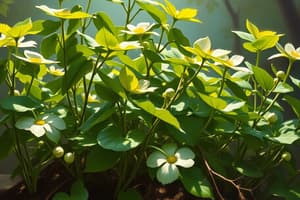Podcast
Questions and Answers
What is photosynthesis?
What is photosynthesis?
Plants use the sun's energy to convert water and carbon dioxide into sugars.
What is the photosynthesis equation?
What is the photosynthesis equation?
6CO2 + 6H2O --> light energy --> C6H12O6 + 6O2
What provides the carbon atoms that are incorporated into sugar molecules in the Calvin cycle?
What provides the carbon atoms that are incorporated into sugar molecules in the Calvin cycle?
Carbon Dioxide (CO2)
What are stomata?
What are stomata?
What is a chloroplast?
What is a chloroplast?
What is chlorophyll?
What is chlorophyll?
What are the reactants of photosynthesis?
What are the reactants of photosynthesis?
What are the products of photosynthesis?
What are the products of photosynthesis?
What is an autotroph?
What is an autotroph?
What is a heterotroph?
What is a heterotroph?
What does 'photo' mean in Latin?
What does 'photo' mean in Latin?
What does 'synthesis' mean in Latin?
What does 'synthesis' mean in Latin?
How many stages of photosynthesis are there?
How many stages of photosynthesis are there?
What is glucose?
What is glucose?
What is the role of roots in plants?
What is the role of roots in plants?
Why do humans need photosynthesis?
Why do humans need photosynthesis?
What is the light reactant needed for photosynthesis?
What is the light reactant needed for photosynthesis?
What is water's role in photosynthesis?
What is water's role in photosynthesis?
What is the chemical compound of water?
What is the chemical compound of water?
What is the main source of energy for life on Earth?
What is the main source of energy for life on Earth?
What do photosynthesizers produce that is needed by organisms?
What do photosynthesizers produce that is needed by organisms?
What is carbon dioxide?
What is carbon dioxide?
What is the function of water in plants?
What is the function of water in plants?
Flashcards are hidden until you start studying
Study Notes
Photosynthesis Overview
- Process by which plants convert sunlight into chemical energy, producing sugars and oxygen.
- Key equation: 6CO2 + 6H2O + light energy → C6H12O6 + 6O2.
Photosynthesis Components
- Carbon Dioxide (CO2): Source of carbon for sugar synthesis during the Calvin cycle.
- Water (H2O): Absorbed by plant roots; essential reactant in photosynthesis.
- Sunlight: Primary energy source that powers photosynthesis.
Photosynthesis Organs
- Chloroplasts: Organelles in plant and algae cells where photosynthesis occurs.
- Stomata (stoma): Small openings on leaf undersides that facilitate gas exchange.
Pigments and Energy
- Chlorophyll: Green pigment in chloroplasts crucial for capturing sunlight during photosynthesis.
Types of Organisms
- Autotroph/Producer: Organisms that produce their own food via photosynthesis.
- Heterotroph/Consumer: Organisms that obtain energy by consuming other living things.
Importance of Photosynthesis
- Key for oxygen production, essential for respiration in many organisms.
- Provides glucose, fundamental for energy in living systems.
Photosynthesis Process
- Consists of two main stages.
- The light-dependent reactions capture sunlight and convert it to chemical energy, while the Calvin cycle uses ATP and NADPH to produce glucose.
Key Terms
- Glucose: A simple sugar (C6H12O6) formed during photosynthesis.
- Reactants: Water, carbon dioxide, and sunlight are necessary for photosynthesis.
- Products: By-products of photosynthesis include glucose and oxygen.
Latin Roots
- Photo: Means "light".
- Synthesis: Means "putting together".
Human Dependency
- Humans rely on photosynthesis for oxygen and food, highlighting its critical role in sustaining life on Earth.
Studying That Suits You
Use AI to generate personalized quizzes and flashcards to suit your learning preferences.




